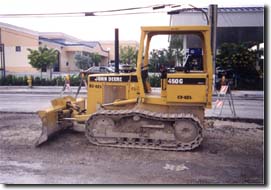EARTHFILL CONSTRUCTION
 Earthfill construction involves three phases: transportation of
concrete from mixer to site, spreading of the concrete in lifts at the
site, and compaction of the concrete. The concrete arrives at the site
by dump truck, instead of by bucket or ready-mix truck, and the concrete
is compacted with vibrating steel-wheel rollers, instead of immersion vibrators.
These methods allow a very rapid construction time. The concrete used is
considered "no slump" concrete. This means that if a small cup is filled
with concrete before it sets, and then turned over and the cup taken away,
it will not lose any height. A lower slump means there is less water present,
and with less water present, the concrete will obtain higher final strength..
The concrete does not need to be workable because it is placed and vibrated
in mass. Placement rates of 5,800 to 12,400 cubic yards per day (4440 and
9480 cubic meters per day) have been achieved and one to two years have
been saved in the construction time of large dam projects. This rapid construction
time allows costs to be decreased by one-half and up to one-third of traditional
concrete dam cost. Soil-cement embankment dams utilize this same method
of construction, however they do not produce the same strength as an RCC
dam.
Earthfill construction involves three phases: transportation of
concrete from mixer to site, spreading of the concrete in lifts at the
site, and compaction of the concrete. The concrete arrives at the site
by dump truck, instead of by bucket or ready-mix truck, and the concrete
is compacted with vibrating steel-wheel rollers, instead of immersion vibrators.
These methods allow a very rapid construction time. The concrete used is
considered "no slump" concrete. This means that if a small cup is filled
with concrete before it sets, and then turned over and the cup taken away,
it will not lose any height. A lower slump means there is less water present,
and with less water present, the concrete will obtain higher final strength..
The concrete does not need to be workable because it is placed and vibrated
in mass. Placement rates of 5,800 to 12,400 cubic yards per day (4440 and
9480 cubic meters per day) have been achieved and one to two years have
been saved in the construction time of large dam projects. This rapid construction
time allows costs to be decreased by one-half and up to one-third of traditional
concrete dam cost. Soil-cement embankment dams utilize this same method
of construction, however they do not produce the same strength as an RCC
dam.
Roller-compacted concrete differs from conventional concrete in its
placement methods. RCC dams gain the strength of conventional concrete
dams while also gaining the dramatically lower price associated with earthfill
methods of construction. The earthfill methods of placement allows much
lower workability and allows increased placement rates that dramatically
lower the cost of the project.
